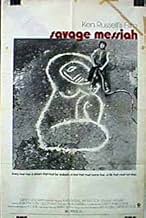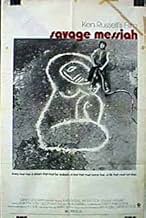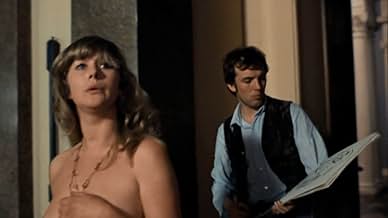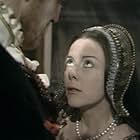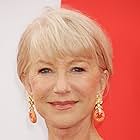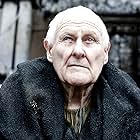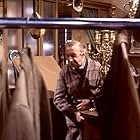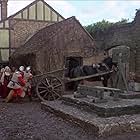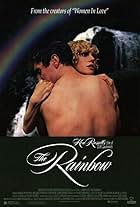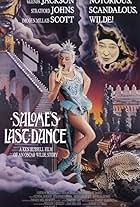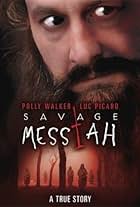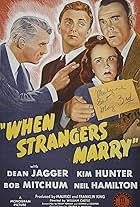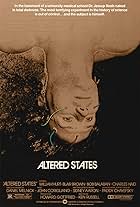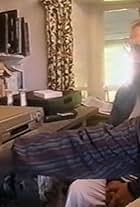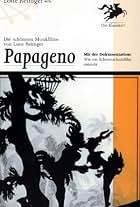VALUTAZIONE IMDb
6,9/10
1709
LA TUA VALUTAZIONE
Aggiungi una trama nella tua linguaBiographical movie of the French sculptor Henri Gaudier-Brzeska.Biographical movie of the French sculptor Henri Gaudier-Brzeska.Biographical movie of the French sculptor Henri Gaudier-Brzeska.
- Nominato ai 1 BAFTA Award
- 1 candidatura in totale
Allan Corduner
- Newspaper vendor outside library
- (non citato nei titoli originali)
Harry Fielder
- Angry Man in Crowd
- (non citato nei titoli originali)
Trama
Lo sapevi?
- QuizEarly in this movie, Henri Gaudier (Scott Antony) is seen in the employ of a certain Mr. Saltzman (Otto Diamant), who hires him, not to create original works as he would like, but to make copies of other people's work. This may be a private joke on producer and director Ken Russell's part, as the producer Harry Saltzman had some years earlier hired him, ostensibly with a view to producing one of Russell's personal projects (a movie about Tchaikowsky), but in fact to make the third movie in the "Harry Palmer" film franchise, Il cervello da un miliardo di dollari (1967). Russell eventually made the Tchaikowsky movie (L'altra faccia dell'amore (1971)) without Saltzman.
- BlooperSophie, a native speaker of Polish, is shown mispronouncing the Polish word rysowac' 'to draw': she says REE-so-vak although the correct Polish pronunciation is (approximately) rih-SOH-vats' (with the final -ts' sound pronounced palatalized, almost like -tch).
- Citazioni
Sophie Brzeska: My book is about sleep; that thick oily substance. Under the surface you float; half dreaming, half waking. Hidden, you hope, yet the world comes though. You cannot imagine the ways I've evolved to abolish myself there... under the surface. Half sleeping. Half waking. Leaving your worries and your clothes asleep. But the rent never sleeps and time never sleeps.
- ConnessioniFeatured in A British Picture (1989)
- Colonne sonoreTWO FLEAS
Composed by Dorothy Tutin
Recensione in evidenza
Savage Messiah is not the easiest of Ken Russell's films. But it is for me the one that deserves our enduring respect as well as the most worthy of securing his place in film history. This is in no small part due to the very articulate script by the great Christopher Logue and glorious sets by Derek Jarman; as well as the impassioned performances of the three main characters. But it is to the director that goes credit for pulling together the artistic vision. We could point out many flaws from specific (more familiar) perspectives; yet the overall film succeeds so admirably in its primary thrust that many such 'criticisms' would be little more than evidence of the viewer missing the point.
The story is a loose biopic of Henri Gaudier, an important and exuberant artist of the early 20th century, who developed a rough-hewn style influencing 20th century modernist sculpture. He abandoned highly finished, polished styles of classical sculpture in favour of an art that is raw and passionate. An 18-year-old self-taught Parisian of great talent and rash, grandiose outbursts, he develops an intense but platonic relationship with Sophie Brzeksa, a cultured woman much older than himself. Their relationship is one of highly charged but unconsummated sexual attraction.
Moving to London, Henri takes his partner's last name. His fame increases as he forefronts Vorticism (which has similarities to Cubism and Futurism). But Gaudier's genius was only recognized after his death at the age of 24, falling in WWI, as a French Army hero twice promoted for bravery. In the film, Russell concentrates on the source of his creativity, his zeal to express his vision, the passionate rage that filled him. Brzeksa's antithesis – and in a way his 'second' muse – is the suffragette Gosh Boyle. Fiercely sexual in a very practical way, Boyle is almost (but not quite) Gaudier's 'Kundry.' While he is a very sexual young man, his art, and his passion for his art, fortunately always comes first. At one point when Brzeksa is refusing his advances, he demands of her five shillings for a whore. Although they are almost penniless, she gives it to him. He pays the whore and uses her to pose for life drawings. But Gosh Boyle is not simply a society siren. In a scene that burns itself on the brain, Helen Mirren, as Gosh, descends a staircase of magnificent Jarmanesque grandeur. It is quite simply perhaps the finest nude scene in film history. Mirren becomes the Greek goddess. Visually she epitomises the height of Greek art – that Gaudier nevertheless wishes to break away from. Sex with Brzeksa (if it ever happened) would be a bonding at the creative level. Sex with Gosh is simply two nice individuals sharing their sexual needs (with good taste).
Brzeksa is writing a book entitled, "Truth – a novel of the Spirit." Gaudier tells her, "You're a genius!" Adding, "I know that cos I'm a genius too." Early scenes have Gaudier publicly making fun of famous sculptures, grabbing stone breasts and so on, leaping around exhibits as if they are playthings, taunting museum security while delivering a tirade. "Art is sex and art is revolution!" Dialogue comes fast and furiously, debating art, the meaning of art, its value, creativity and the sources of creativity, whether art begets art and whether anything is truly original.
As a sculptor, Gaudier speaks of the stone 'leading the artist in.' But his passion for the work is like the fusion of hydrogen and oxygen, creativity exploding on the viewer with unstoppable force. He is the 'mad' artist whose madness rents the veil of the world. One night he captivates a dinner party and Bond Street gallery owner with his ideas. They excuse his atrocious table manners in the name of art, but insist he produce a torso that he has so eloquently described. He arranges an appointment with the upper-class potential buyer at 8am the next day, steals stone from a cemetery, and works feverishly all night to produce the bust. If artistic licence is used to portray 'facts,' it is done to convey the spirit.
A key to understanding the flamboyance of Russell is the work of Antonin Artaud, both his philosophy and his studies of film theory. Artaud sought a cinematic experience powerful enough to throw the viewer beyond their civilised self and rediscover their primitive instincts. Like Gaudier's denunciation of classical art, he rejected the polished result of mainstream cinema that, in many ways, tries to replicate reality or become a variation of the literary/theatrical experience. He also rejects the verité style that can be devoid of emotion. Artaud proposal is diametrically opposed to Brechtian distanciation. Artaud, who was a strong influence on Russell, was the opposite: he would seek to overpower the audience with sensory input and thence achieve a sort of trancelike state. His technique is often referred to as 'theatre of cruelty,' stripping away the veneer of civilization, disturbing audience by revealing the forces of nature. Russell's Gaudier also strips away rose-tinted social fallacies. "You know the public – if an artist isn't miserable, he's nothing!" He prophesises the effect of the war: "If the war comes it will kill the artists but not the dealers." The enthusiastically polemic tone can be tiring for the viewer. There are points where we want to sympathise with his critics and tell him to "shut up and grow up." We would like Russell to offer up Gaudier for our delectation in more traditional or intellectual style. But to do that would not only be untrue to Gaudier and the creative spirit described. It would be untrue to Russell.
This self-financed film was a commercial disaster for Russell. Yet he still describes it as his best film and the one for which he would most wish to be remembered. If that is to happen, it will, at some point, need to become more readily available.
The story is a loose biopic of Henri Gaudier, an important and exuberant artist of the early 20th century, who developed a rough-hewn style influencing 20th century modernist sculpture. He abandoned highly finished, polished styles of classical sculpture in favour of an art that is raw and passionate. An 18-year-old self-taught Parisian of great talent and rash, grandiose outbursts, he develops an intense but platonic relationship with Sophie Brzeksa, a cultured woman much older than himself. Their relationship is one of highly charged but unconsummated sexual attraction.
Moving to London, Henri takes his partner's last name. His fame increases as he forefronts Vorticism (which has similarities to Cubism and Futurism). But Gaudier's genius was only recognized after his death at the age of 24, falling in WWI, as a French Army hero twice promoted for bravery. In the film, Russell concentrates on the source of his creativity, his zeal to express his vision, the passionate rage that filled him. Brzeksa's antithesis – and in a way his 'second' muse – is the suffragette Gosh Boyle. Fiercely sexual in a very practical way, Boyle is almost (but not quite) Gaudier's 'Kundry.' While he is a very sexual young man, his art, and his passion for his art, fortunately always comes first. At one point when Brzeksa is refusing his advances, he demands of her five shillings for a whore. Although they are almost penniless, she gives it to him. He pays the whore and uses her to pose for life drawings. But Gosh Boyle is not simply a society siren. In a scene that burns itself on the brain, Helen Mirren, as Gosh, descends a staircase of magnificent Jarmanesque grandeur. It is quite simply perhaps the finest nude scene in film history. Mirren becomes the Greek goddess. Visually she epitomises the height of Greek art – that Gaudier nevertheless wishes to break away from. Sex with Brzeksa (if it ever happened) would be a bonding at the creative level. Sex with Gosh is simply two nice individuals sharing their sexual needs (with good taste).
Brzeksa is writing a book entitled, "Truth – a novel of the Spirit." Gaudier tells her, "You're a genius!" Adding, "I know that cos I'm a genius too." Early scenes have Gaudier publicly making fun of famous sculptures, grabbing stone breasts and so on, leaping around exhibits as if they are playthings, taunting museum security while delivering a tirade. "Art is sex and art is revolution!" Dialogue comes fast and furiously, debating art, the meaning of art, its value, creativity and the sources of creativity, whether art begets art and whether anything is truly original.
As a sculptor, Gaudier speaks of the stone 'leading the artist in.' But his passion for the work is like the fusion of hydrogen and oxygen, creativity exploding on the viewer with unstoppable force. He is the 'mad' artist whose madness rents the veil of the world. One night he captivates a dinner party and Bond Street gallery owner with his ideas. They excuse his atrocious table manners in the name of art, but insist he produce a torso that he has so eloquently described. He arranges an appointment with the upper-class potential buyer at 8am the next day, steals stone from a cemetery, and works feverishly all night to produce the bust. If artistic licence is used to portray 'facts,' it is done to convey the spirit.
A key to understanding the flamboyance of Russell is the work of Antonin Artaud, both his philosophy and his studies of film theory. Artaud sought a cinematic experience powerful enough to throw the viewer beyond their civilised self and rediscover their primitive instincts. Like Gaudier's denunciation of classical art, he rejected the polished result of mainstream cinema that, in many ways, tries to replicate reality or become a variation of the literary/theatrical experience. He also rejects the verité style that can be devoid of emotion. Artaud proposal is diametrically opposed to Brechtian distanciation. Artaud, who was a strong influence on Russell, was the opposite: he would seek to overpower the audience with sensory input and thence achieve a sort of trancelike state. His technique is often referred to as 'theatre of cruelty,' stripping away the veneer of civilization, disturbing audience by revealing the forces of nature. Russell's Gaudier also strips away rose-tinted social fallacies. "You know the public – if an artist isn't miserable, he's nothing!" He prophesises the effect of the war: "If the war comes it will kill the artists but not the dealers." The enthusiastically polemic tone can be tiring for the viewer. There are points where we want to sympathise with his critics and tell him to "shut up and grow up." We would like Russell to offer up Gaudier for our delectation in more traditional or intellectual style. But to do that would not only be untrue to Gaudier and the creative spirit described. It would be untrue to Russell.
This self-financed film was a commercial disaster for Russell. Yet he still describes it as his best film and the one for which he would most wish to be remembered. If that is to happen, it will, at some point, need to become more readily available.
- Chris_Docker
- 26 giu 2010
- Permalink
I più visti
Accedi per valutare e creare un elenco di titoli salvati per ottenere consigli personalizzati
- How long is Savage Messiah?Powered by Alexa
Dettagli
- Tempo di esecuzione1 ora 37 minuti
- Mix di suoni
- Proporzioni
- 1.78 : 1
Contribuisci a questa pagina
Suggerisci una modifica o aggiungi i contenuti mancanti

Divario superiore
By what name was Messia selvaggio (1972) officially released in India in English?
Rispondi

